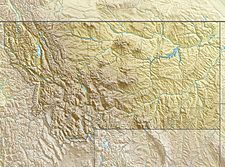Snowbank Glacier facts for kids
Quick facts for kids Snowbank Glacier |
|
|---|---|
| Type | Mountain glacier |
| Location | Beartooth Mountains, Carbon County, Montana, United States |
| Coordinates | 45°05′38″N 109°41′02″W / 45.09389°N 109.68389°W |
| Area | Approximately 120 acres (0.49 km2) for both lobes |
| Length | .45 mi (0.72 km) |
| Terminus | Talus |
| Status | Unknown |
Snowbank Glacier is a cool natural ice formation found high up in the Beartooth Mountains in the U.S. state of Montana. Imagine a giant, slow-moving river of ice! That's what a glacier is. Snowbank Glacier sits at a very high elevation, about 10,600 feet (3,200 m) above sea level. It's located right next to a peak called Snowbank Mountain.
This glacier is special because it's split into two main parts, almost like two separate ice patches. These are called the west lobe and the east lobe. Both parts are roughly the same size.
Contents
What is a Glacier?
A glacier is a huge mass of ice that moves very slowly over land. It forms over many, many years as snow falls and piles up in one place. The snow gets compressed and turns into ice. Think of it like making a giant snowball, but on a much bigger scale and over a long time!
How Glaciers Form
Glaciers need two main things to form: lots of snow and cold temperatures. When more snow falls in winter than melts in summer, it starts to build up. The weight of the new snow on top squishes the snow below it. This pressure turns the fluffy snow into hard, dense ice.
Over time, this ice becomes so thick and heavy that it starts to flow downhill, even if it's very slowly. This slow movement is what makes a glacier a "river of ice."
Snowbank Glacier's Location and Size
Snowbank Glacier is nestled in the rugged Beartooth Mountains. This mountain range is known for its tall peaks and beautiful, wild landscapes. Being in Montana, the glacier experiences cold winters that help it survive.
Two Parts of the Glacier
As mentioned, Snowbank Glacier isn't just one big block of ice. It's divided into two distinct sections:
- The west lobe
- The east lobe
Each of these lobes covers an area of about 60 acres (0.24 km2). Together, they make up the entire Snowbank Glacier.
The Proglacial Lake
Near the northern edge of the west lobe, you can find a special body of water called a proglacial lake. A proglacial lake is a lake that forms right in front of a glacier. It's usually created by the meltwater from the glacier itself. As the glacier melts, the water collects in depressions in the land, forming a lake. These lakes are often very cold and can sometimes contain icebergs that have broken off the glacier.
Why Glaciers are Important
Glaciers like Snowbank Glacier are important for several reasons. They are a huge source of fresh water, storing it as ice. When they melt slowly, they can feed rivers and streams. They also help scientists understand Earth's climate history. By studying glaciers, we can learn about past temperatures and snowfall.


